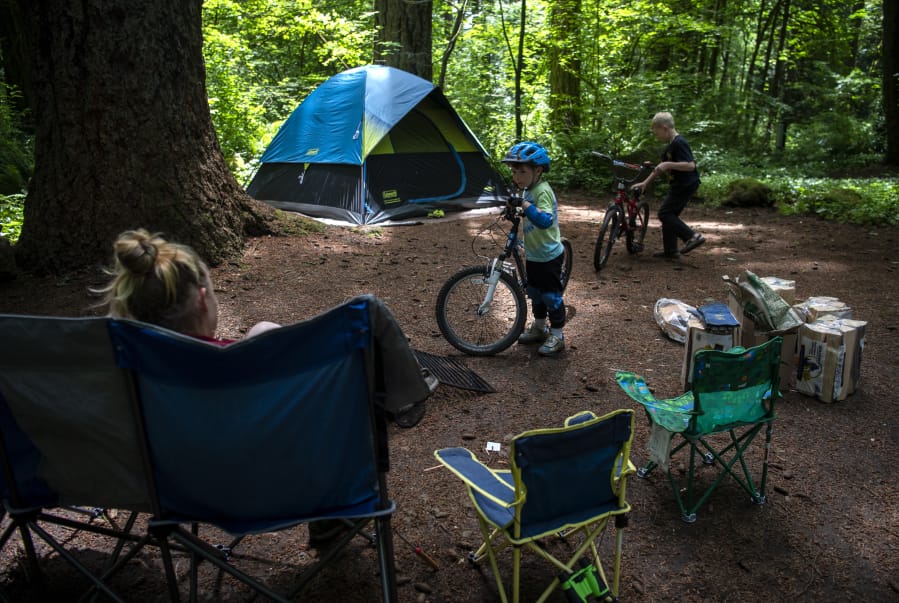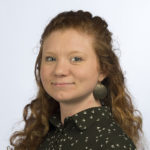Mother Nature couldn’t care less about the pandemic. Summer arrived just the same. Many of us in the Pacific Northwest have grown tired of staring longingly out the window. We find ourselves wondering if it might be safe to get outside and enjoy camping.
Health experts agree: Going outside is safer than any indoor activities during the pandemic. As a result, camping — whether in a tent, yurt or RV — may rebound faster than other forms of recreation and travel, which have plummeted worldwide. While hotels remain practically deserted, some campgrounds are experiencing a boom.
“Weekends we’ve been full,” said Heath Yeats, Battle Ground-area manager with the Washington State Parks and Recreation Commission. He oversees Battle Ground Lake, Paradise Point and Beacon Rock state parks, which collectively offer 112 standard campsites.
“During the week, we’re half to three-quarters full, which is pretty standard occupancy for this time of year,” he said. “The weather was quite wet for June. That slowed things down a little bit but now we’re basically back to pre-COVID-19 occupancy.”
Record-breaking interest
Kampgrounds of America, which bills itself as the “world’s largest system of open-to-the-public campgrounds,” recently released its annual North American Camping Report, this year gauging leisure travelers’ attitudes toward camping during and after the pandemic.
Of those surveyed, 41 percent still planned to take their trips, while others said they would cancel or postpone. Prior to the pandemic, camping accounted for 11 percent of all trips. The report predicts that figure will jump 5 percent post COVID-19. Interest in camping has grown in general in the past decade, the report states, “adding millions of new camping households each year.”
At least one Portland-based startup is seeing the effects of that interest.
“Camping is going to hit a record-breaking increase this year and that’s only going to be magnified,” said Kevin Long, CEO of The Dyrt, a startup with offices in Southeast Portland that describes itself as the Yelp of campgrounds.
Users can download The Dyrt on their smartphones to discover campsites all over the United States.
“Our website — this month last year, we had about 600,000 visitors. We finished out May 2020 with 1.1 to 1.2 million visitors,” Long said.
About 7,500 people in Vancouver have visited The Dyrt for camping information so far this year, according to the company.
“I can’t think of a single easier, more socially distanced activity than camping,” Long said.
But if a lot of people flock to campsites, is it safe?
Safety
Public health officials advise not to travel too far.
“Camping can be safer than other activities, depending on the circumstances,” said Marissa Armstrong, Clark County Public Health spokeswoman. “We want people to stick close to home because the virus may be spreading more or less in other communities. In addition, counties are in different phases of the reopening process. What’s allowed in one county may not be allowed in another county.”
Long offered another piece of advice for staying healthy.
“When you go camping with friends, BYOS: bring your own stuff,” Long said. “Camping has traditionally been a, ‘Hey let’s all cook together, let’s share drinks.’ But we all have a social responsibility to be smart about how we go back outside.”
Camping with people from your household is the safest option because traveling with others increases the risk of spreading the virus, Armstrong said. Campers should still stay 6 feet or more apart and wear face masks in public areas.
“People who are camping with the same people they live with can enjoy the time outdoors without much of an increased risk,” she said. “This is because their exposures wouldn’t be much different than if they were at home.”
Regardless, groups should include no more than five people from outside the household, which is the largest gathering allowed in the second of the state’s four-phase reopening plan, where Clark County remains.
At this point, we’re all well aware of the need to frequently wash hands or use hand sanitizer, and it’s no different while camping, experts say. And public bathrooms? If you can’t avoid them, be sure to wear a face covering, since research shows that the virus may linger in the air. Avoid touching any surfaces.
You could bring a portable restroom (that is, a bucket), such as a Luggable Loo, which can be placed in a small stand-up tent for privacy. Deeper in the woods, doing your business and burying it may be an option, but some public lands require that you pack out everything, including human waste.
Amenities vary
Campers should plan ahead and check what amenities, if any, are available at the campground they select. Several agency officials repeated the same line: “Know before you go.”
“It’s kind of all over the board, as far as what’s open,” Yeats said of the state parks system. “It’s about really coming prepared, knowing what to expect, and having a Plan B. As we get to some of these warmer temperatures, some of the water access points are going to be pretty crowded.”
Facilities may not be maintained daily. Even commercial campgrounds may not offer running water or have open restrooms. Some state parks have had their budgets cut and staff reduced, leaving it up to campers to bring their own supplies.
“With the facilities, no one is promising a COVID-free environment,” said Kyung Koh, recreation program manager at Gifford Pinchot National Forest. “We’re cleaning as much as we can, but we can’t clean it every time. That’s just not possible. We’re making these decisions on if we have the staff available and if we have the cleaning supplies. I think it’s safe to say we’re not cleaning them daily unless you’re at a concession campground and there’s a host.”
Yeats said at Battle Ground Lake, the park has increased the amount of time between check-in and check-out to “allow staff to do a really thorough cleaning.”
Some campgrounds have reduced the number of available walk-up sites in favor of reservations. At Gifford Pinchot, Koh said previously it was about “a 60-40 divide,” but now 90 percent of spots require a reservation ahead of time and some spots may be closed to provide better physical distancing.
You can avoid other people by finding your own spot outside of a designated campground, known as dispersed camping.
Only certain public lands allow it. Although it provides better opportunities for isolation — and is free — it has its own restrictions. There are no hosts or amenities. Dispersed campers must not clear any vegetation to make a site. Some areas require campers to be at least 200 feet away from a water source. It’s best to contact the land manager directly to ask about restrictions.
Because dispersed camping isn’t as closely monitored, messes — litter and human waste — are often a problem.
“What we are seeing across the nation is just an increase in use in public lands. I think what that means is there’s people new to recreation and they may not know what to do when they’re recreating,” Koh said. “It’s great if they can pack up their own trash.”
‘Let’s slow down’
For Long, he has seen the pandemic not just as a pause button, but “an entire reset of what’s important to me and a re-evaluation of my values.”
And camping, he said, is a way to “start turning the social engine of our country back on.”
“I mean, think about your own time six months ago. What did you do on a Tuesday night? After work and your weekends, you’re exhausted on Mondays. Going grocery shopping and meeting four different people in five different places,” he said. “It’s been incredible to step back and spend some time with my family and spend some time relaxing. This is where people are coming back out with this new set of values and what’s important to them. I think it’s another piece of the engine that’s sparking interest in camping. It’s like, let’s slow down. It doesn’t have to be all these crazy bells and whistles.”




